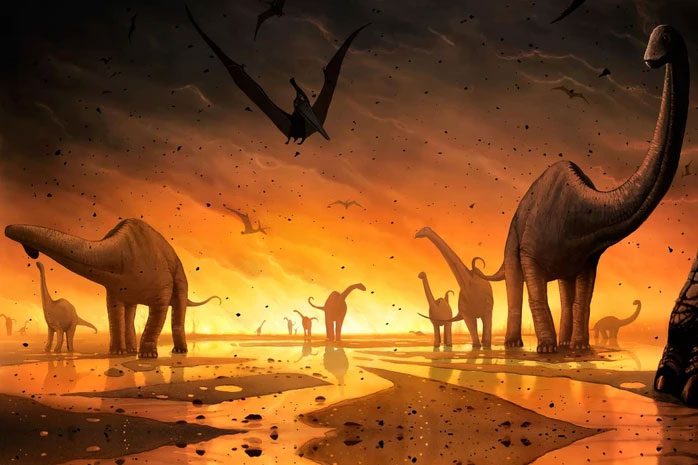A more terrifying force than the massive Chicxulub space rock may have existed on Earth, acting as the “death sentence” for the dinosaurs even before the cosmic disaster struck.
According to Science Alert, a new analysis from an international team of scientists has provided evidence that the world before the Chicxulub impact was already a “hell”, with atmospheric sulfur levels reaching critical thresholds.
Alongside other studies on mercury content, this research offers proof of volcanic activity strong enough to cause significant climate change on Earth 66 million years ago.

The Day of Dinosaur Doom – (Graphic: LIVE SCIENCE).
“Our data suggests that this could lead to a global temperature drop in a short time“ – said geologist Sara Callegaro from the University of Oslo (Norway), the lead author of the study.
This statement refers to the so-called “volcanic winter”, as an earth response following a period turned into “hell” due to massive volcanic eruptions, a suffocating sky filled with sulfur and ash, blocking sunlight from reaching the ground, combined with other climate-cooling molecules, which significantly affected living organisms.
Previously, the “volcanic winter” hypothesis had support, but a gigantic meteorite – the Chicxulub asteroid – was believed to trigger the chain of eruptions.
By examining ancient rocks from the Deccan Traps volcanic region in Western India, scientists measured sulfur concentrations over time, indicating that emissions from this area were sufficient to alter global climate by releasing 1 million km³ of lava.
The formation of sulfur-rich lava in this region also aligns with the cooler climate of the Cretaceous period. When the lava solidified after the eruption, climate-cooling molecules were released into the atmosphere.
This series of disasters caused global temperatures to drop sharply by 10 degrees Celsius over 100,000 years before Chicxulub delivered the final blow.
Thus, the Earth itself was the primary cause of the end of the “Age of the Monsters”. The Chicxulub asteroid only played a collaborative role; even without it, climate change would have been enough to wipe out the dinosaurs.
The Chicxulub asteroid is a massive space rock, which many studies suggest was the primary cause of the dinosaur extinction 66 million years ago, at the end of the Cretaceous period.
Chicxulub was so large that it left a crater over 180 kilometers in diameter, stretching from part of the Yucatan Peninsula in Mexico to the Gulf of Mexico’s coastline.
It’s difficult to estimate the exact size of this asteroid as it fragmented after impact, but it is certainly one of the largest objects ever to strike Earth, with shockwaves from the collision capable of causing unprecedented tsunamis, earthquakes, and massive volcanic eruptions…


















































